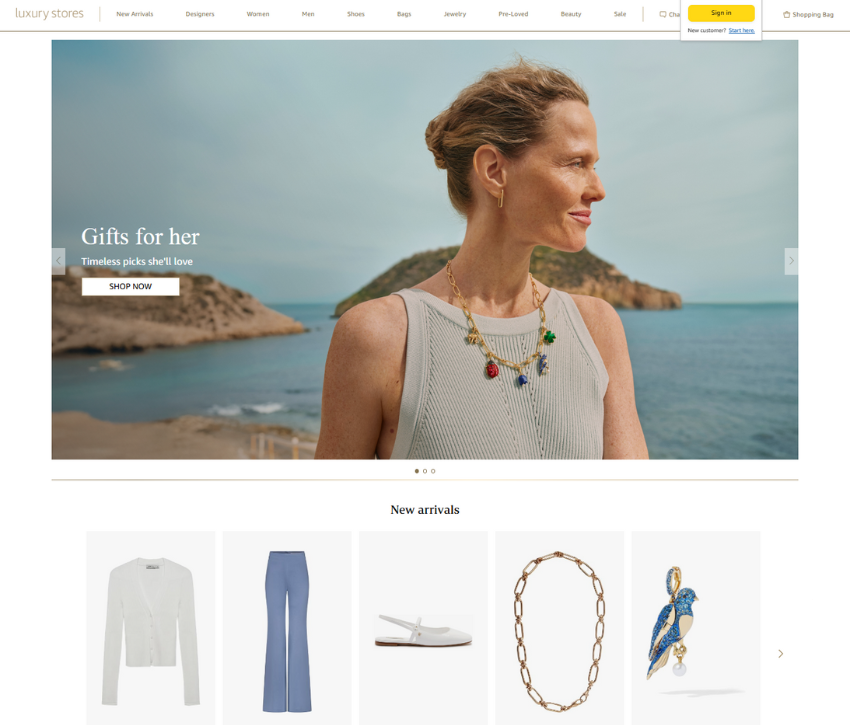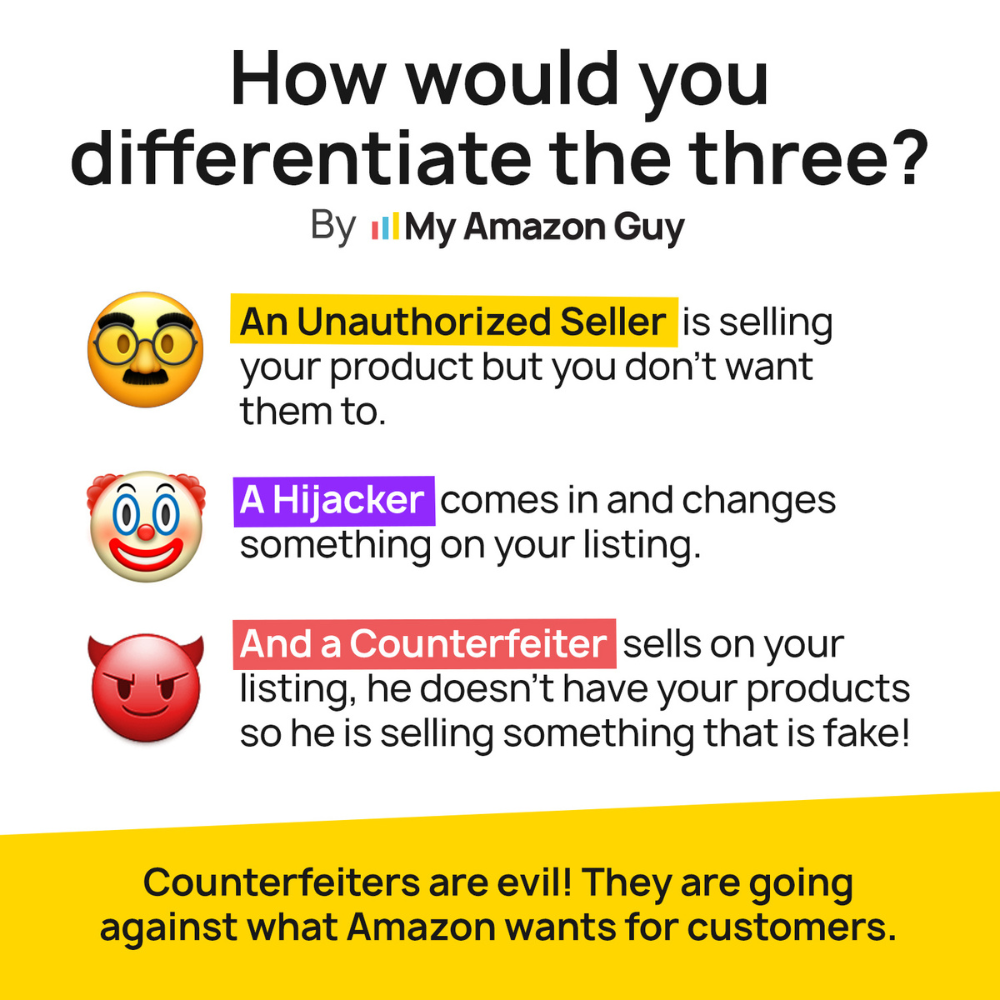Last Updated: 04/17/2025
Summary: Amazon Luxury Stores is a curated platform for premium fashion and beauty brands. To qualify, you must meet strict criteria, protect your brand, and offer a high-end customer experience with optimized listings and top-tier service.
Would you ever imagine seeing a $2,000 handbag or a luxury skincare set right next to paper towels on Amazon? Just a few years ago, that might have sounded farfetched, but today there’s Amazon Luxury Stores.
When most people think of Amazon, they likely envision everyday household items or tech gadgets, not luxury goods. However, that perception is shifting since premium brands are coming to Amazon to sell their high-end products like designer fashion, fine jewelry, and premium watches.
This is because more and more luxury brands are seeing the value of Amazon’s global reach and built-in customer trust. Selling luxury items on Amazon may seem counterintuitive for some, but with the right strategy and execution, it can be a highly profitable channel.
In this post, our Amazon agency will walk you through how to successfully sell luxury items on Amazon. Whether you’re an established luxury brand or an authorized reseller, this guide will help you get started and stand out on Amazon’s luxury marketplace.
Table of Contents
What Is Amazon Luxury?
Amazon Luxury is a curated shopping experience offering high-end fashion and beauty products. It combines Amazon’s convenience with the exclusivity expected from luxury shopping.
Launched as Amazon Luxury Stores, this section is available to invited Prime members in the U.S. It offers access to exclusive products from sought-after luxury brands, with each brand having its own dedicated storefront.
Unlike regular Amazon listings, where any seller can list items, Amazon Luxury operates with a controlled, premium experience. Invited members can shop within a secure environment designed for a more exclusive feel.
The shopping experience is enhanced with features like 360-degree viewing for select items, helping customers interact with products. This innovation aims to make luxury shopping more engaging and convenient.
Customers can browse brand storefronts or explore all available luxury items. Purchases are made through a separate checkout, distinct from regular Amazon orders.
Product Eligibility and Categories in Amazon Luxury Stores
Amazon Luxury Stores is an invite-only platform designed to offer a premium shopping experience. Brands must meet strict criteria related to quality, authenticity, and presentation to be considered.
Brand and Product Eligibility
Not all premium products or even well-known brands qualify for Amazon Luxury Stores. To be eligible, a brand must:
- Be recognized as a premium or luxury label
- Demonstrate strong market presence and reputation
- Maintain high standards for packaging, fulfillment, and customer service
- Be enrolled in Amazon Brand Registry with a registered trademark
- Receive a direct invitation from Amazon (there is no open application process)
Amazon Luxury Stores Product Categories
The platform focuses on two primary categories: fashion and beauty. Only select products within these segments are featured to uphold the store’s exclusive appeal.
- Fashion
Includes designer apparel, handbags, footwear, and accessories. These brands are known for exceptional craftsmanship, exclusivity, and brand heritage. - Beauty
Covers high-end skincare, cosmetics, fragrances, and wellness products. These items stand out for their premium ingredients, refined branding, and upscale presentation.
How to Sell Luxury Brands on Amazon
Selling luxury brands on Amazon involves stricter requirements than typical listings, including brand approval, product authenticity, and premium presentation. Knowing the guidelines and following the step-by-step process can help you successfully meet these requirements and list your luxury products with confidence.
Amazon Guidelines for Selling Luxury Items
Before selling luxury items on Amazon, sellers must adhere to specific policies. These policies help protect both buyers and sellers while maintaining the integrity of the luxury marketplace.
General Requirements for Selling Luxury Items on Amazon
- Authenticity
Every item must be 100% genuine. Amazon takes counterfeits seriously and verifies products thoroughly.
- Brand Approval
You must have permission from the brand owner or an authorized distributor. Without proof of authorization, your listings can be removed.
- Condition of Products
Items must be in new, unused condition. That means original packaging, tags, accessories, and no signs of wear.
- Pricing
Prices should match market value and stay within Amazon’s pricing rules. Overpricing or underpricing can lead to listing issues.
Additional Requirements for Amazon Luxury Stores
Brand Store Setup
- Amazon will provide you with a dedicated page for your brand (called a “Brand Store”).
- You’re responsible for adding high-quality visuals like videos, listing images, or runway content to make your page look premium.
Fees
- Amazon charges a referral fee and a premium experience fee:
- Fashion items: 20% total (15% + 5%)
- Beauty items: 30% total (15% + 15%)
- If you sell in the UK or EU, you may have a small increase due to local taxes.
Fulfillment Options
- You can use Fulfillment by Amazon, Fulfillment by Merchant, or both.
- FBA: Standard Amazon fees apply, but return and removal fees are waived.
- FBM: You must provide free three-day shipping to all customers in the EU, UK, and Switzerland.
Customer Service Standards
- Respond to customer questions within 24 hours on weekdays and by the next business day on weekends or holidays.
- You must forward customer messages to Amazon’s Luxury Stores support team.
- For FBM orders, Amazon may contact you to take specific actions related to orders or returns.
Returns and Refunds
- You must accept free returns on all luxury products.
- Customers get a pre-paid return label automatically.
- You must refund customers within two business days after receiving the returned item.
- If the product meets return conditions, you must give a full refund without any restocking fee.
- For FBM returns, you’ll be responsible for the shipping cost.
Shipping and Performance Metrics
- You must meet the following standards:
- At least 99% on-time shipment rate
- At least 99% tracking rate
- Cancellations under 0.5%
- At least 97% on-time delivery rate (for non-Buy Shipping orders)
Brand Registry
- You must be enrolled in Amazon’s Brand Registry and maintain an active account to participate in Luxury Stores.
Step-by-Step Guide for Selling Luxury Items on Amazon
Luxury items can be sold on Amazon through direct brand sales via Amazon Luxury Stores or by reselling branded products as an authorized seller. Both approaches offer viable opportunities depending on your business model.
For Direct Brand Sales: Selling Your Own Luxury Items
Selling luxury items directly through Amazon Luxury Stores is the most straightforward and authorized method for brands to reach luxury shoppers. Here’s how to get started:
- Create a Brand Account
First, register as a seller on Amazon Seller Central and ensure your brand is eligible to participate in Amazon Luxury Stores. Amazon requires that only specific, high-end brands can be part of this exclusive marketplace. - Enroll in Amazon Brand Registry
You must enroll in the Amazon Brand Registry to sell luxury items directly. This gives you control over your listings and brand, along with enhanced marketing features like A+ Content and additional protections against counterfeiting. - Verify Product Authenticity
Amazon requires all luxury items to be 100% authentic. You will need to provide proof of authenticity and ensure your products comply with all necessary standards for luxury goods. - List Your Products in Luxury Stores
Once enrolled, you can create a dedicated storefront in Amazon Luxury Stores. Here, you can list your high-end fashion, beauty, and lifestyle products, showcasing them alongside other top-tier luxury brands. - Ensure Quality and Condition
Luxury items listed in Amazon Luxury Stores must meet Amazon’s strict requirements for condition, including original packaging, tags, and accessories.
For Resellers: Selling Branded Luxury Items on Amazon
If you are a third-party seller and want to resell luxury items that you don’t own but have permission to sell, here’s a guide for that process. This alternative approach involves selling luxury items from authorized brands, rather than directly managing the brand yourself:
- Become an Authorized Seller
Secure approval from the brand owner or authorized distributor to sell luxury products. You need to show proof of purchase, such as invoices or authorization letters. - Register as a Third-Party Seller
Start by signing up as a third-party seller on Amazon, which gives you access to listing and selling products on the marketplace. - Verify Product Authenticity
Make sure the products you’re selling are 100% authentic. You cannot sell counterfeit items, and Amazon will require proof of authenticity for all luxury goods. - List Items on the Correct ASIN
If you’re reselling luxury items, your listings must match the existing ASINs. Ensure that the brand, style, color, and product details match perfectly. - Enroll in Amazon Brand Registry (Optional)
If you have authorization to resell a specific luxury brand, enrolling in the Amazon Brand Registry may be beneficial for protecting your listings against counterfeiters or unauthorized sellers.
Seen a New Seller Central Update? Let Us Know!
Amazon Seller Central constantly updates its interface. If you spot a change we missed, let us know using the form below!
Luxury Items Selling Strategy on Amazon
Selling luxury items on Amazon requires a tailored approach to ensure your products stand out. Since high-value goods demand a premium experience, here are some key strategies to maximize sales, maintain brand integrity, and ensure customer satisfaction on the platform.
1. Invest in High-Quality Product Listings
Investing in high-quality product listings is essential for attracting discerning customers. Professional, high-resolution images should highlight product details and craftsmanship from multiple angles, while optimized titles and descriptions emphasize unique features.
Enhance listings with A+ Content, which adds rich text and visuals to showcase the product’s value and tell a compelling brand story. This approach ensures luxury items stand out and engage potential buyers effectively.
2. Build Trust with Social Proof and Reviews
Customer trust is crucial when selling luxury goods. Encouraging satisfied customers to leave verified reviews helps build credibility, while proactively addressing customer concerns maintains confidence in your brand.
Social media, including customer photos and influencer endorsements, can further enhance the authenticity of your listings. These strategies reassure potential buyers and strengthen your brand’s reputation.
3. Use Amazon Advertising and SEO to Boost Visibility
Effective advertising and SEO are key to getting your luxury products in front of the right audience. Use Sponsored Products and Sponsored Brands to boost visibility while protecting your brand from competitors.
Focus on long-tail keywords and brand-specific terms to improve search rankings and filter out irrelevant products. Enrolling in Brand Registry helps protect your listings from counterfeiting, ensuring your brand’s integrity.
4. Offer Premium Customer Service and Experiences
Luxury customers expect a premium experience from start to finish. Provide personalized recommendations and exceptional customer support to enhance their journey.
Implement clear and flexible return policies to build trust and ensure peace of mind. Offering exclusive perks, such as free gift wrapping or styling consultations, can further elevate the overall value proposition.
5. Understand Your Target Audience and Consumer Behavior
Tailor your marketing to the preferences and behaviors of luxury shoppers. Focus on middle-income buyers, who make up a large portion of luxury consumers, by aligning your messaging with their aspirations.
Engage millennials, especially millennial men, through digital channels like streaming TV and Twitch. Use key occasions such as birthdays and holidays, along with year-round messaging, to target self-gifting trends and maximize engagement.
6. Manage Your Inventory and Pricing Effectively
Effective inventory management and competitive pricing are essential for high-ticket items. Price your products to align with market expectations while preserving the luxury image.
Offer flexible payment plans to make luxury purchases more accessible. Maintain optimal inventory levels to avoid stockouts or overstocking, which can negatively impact pricing and brand perception.
7. Keep Your Brand Protected
Protecting your brand’s integrity ensures customer trust in your luxury offerings. Control distribution to maintain consistency and safeguard your brand’s reputation.
Use Amazon tools like Transparency and Brand Registry to defend against counterfeiters and unauthorized sellers. These steps help preserve the authenticity and quality of your luxury products.
The Benefits of Selling Luxury Brands on Amazon
Selling luxury items on Amazon presents numerous opportunities for brands to reach a global audience and streamline their operations. The platform’s massive reach and advanced tools offer distinct advantages for luxury brands, helping them grow and thrive in the competitive online marketplace.
Here are some key benefits of selling luxury goods on Amazon:
- Increased Reach and Global Exposure
Amazon provides luxury brands with access to a vast customer base of over 300 million active users worldwide. This global reach helps brands expand their market presence, especially in areas with limited access to high-end department stores, making luxury goods more accessible to consumers in underserved regions.
- Access to Valuable Customer Data and Analytics
Amazon offers detailed customer insights, helping luxury brands better understand their audience’s preferences, behaviors, and buying patterns. This data allows brands to optimize product offerings and marketing strategies, ensuring they stay relevant and aligned with customer demands.
- Streamlined Fulfillment and Supply Chain Management
By utilizing Amazon’s extensive fulfillment network, luxury brands can simplify their logistics and ensure fast, reliable delivery. With options like one-day and two-day shipping, as well as free shipping for Prime members, brands can offer an excellent customer experience while reducing operational complexities.
- Strong Brand Protection Measures
Luxury brands often face challenges with counterfeits and unauthorized sellers. Amazon has implemented stringent brand protection policies through its Brand Registry and other measures, allowing brands to safeguard their products and ensure they’re sold to legitimate customers.
Drawbacks of Selling Luxury Items on Amazon
Selling luxury goods on Amazon comes with some key challenges that brands need to consider. Despite its vast reach, the platform may not align perfectly with the exclusivity and premium experience that luxury brands offer.
Here are the common drawbacks to keep in mind:
- Loss of Brand Experience
Amazon’s mass-market environment can dilute the personalized and high-end customer experience that luxury brands are known for. The platform’s standard packaging, generic communication, and lack of customization may compromise the luxury feel. - Fulfillment and Delivery Challenges
While FBA simplifies logistics, it can negatively impact the luxury customer experience. Brands lose control over how their products are packed and shipped, potentially diminishing the perceived value of the product. - Risk of Lower Perceived Value
Amazon’s marketplace can make luxury goods too accessible, reducing their exclusivity. As availability increases, the rarity of luxury items decreases, which can harm the brand’s desirability and reputation. - Counterfeit and Unauthorized Sellers
Counterfeit products and unauthorized resellers are a significant risk on Amazon. Despite brand protection tools like Brand Registry, maintaining full control over the authenticity and distribution of luxury items remains a constant challenge.
Types of Products Featured in Amazon Luxury Stores
Amazon Luxury Stores offers a wide range of high-end products, featuring carefully curated selections that reflect the exclusivity and prestige of the luxury market. Here are the types of products shoppers can see in Amazon Luxury Stores:
Apparel
High-end clothing from luxury designers, including seasonal collections, ready-to-wear pieces, and iconic fashion items.Handbags
A selection of premium handbags and accessories from renowned brands, featuring classic styles and limited-edition pieces.Shoes
Luxury footwear, from designer heels to elegant flats and sneakers, often incorporating unique materials and craftsmanship.Accessories
A variety of luxury items, such as scarves, belts, wallets, sunglasses, and jewelry, which complement fashion collections.Beauty and Fragrance
Exclusive skincare, cosmetics, and fragrances from prestigious beauty brands, offering high-quality products for a luxury experience.Watches
High-end timepieces from top global watchmakers, blending design with advanced technology.Fine Jewelry
A collection of exquisite jewelry pieces, including diamonds, gold, and precious gemstones, from celebrated jewelers.Pre-Loved
A curated collection of pre-owned luxury goods, including handbags, shoes, and accessories, offering customers the chance to purchase timeless pieces at a more accessible price point.
FAQs About Selling Luxury Items on Amazon
What are Luxury Stores on Amazon?
Amazon Luxury Stores is a curated section within the platform that offers high-end fashion, beauty, and lifestyle products from exclusive luxury brands. These stores provide a premium shopping experience with features like dedicated brand storefronts, enhanced product details, and personalized customer service, all accessible through the Amazon mobile app.
How do you get invited to Amazon Luxury Stores?
To be invited to sell in Amazon Luxury Stores, sellers need to meet specific eligibility criteria. Typically, only luxury brands or authorized distributors are invited.
However, Amazon also allows some brands to request an invitation via the Luxury Stores landing page. Invitations are usually extended to established luxury brands that meet Amazon's standards for quality and exclusivity.
I’m a small luxury brand, how can I sell my products on Amazon?
Start by applying for approval and ensuring you're authorized to sell the products. Enroll in Amazon Brand Registry to protect your IP and boost visibility. If you're not eligible for Luxury Stores, the third-party marketplace is a solid option.
Hiring an Amazon account manager or Amazon agency can streamline the process, optimize your listings, and help you grow faster with expert support.
What’s the future for selling luxury items on Amazon?
The future of selling luxury items on Amazon looks promising as more luxury brands begin to embrace e-commerce. With growing demand for online luxury shopping and Amazon's continuous enhancements to its platform, more brands are likely to join Amazon Luxury Stores.
Key Takeaways for Selling in Amazon Luxury Stores
Selling in Amazon Luxury Stores gives both luxury brands and authorized resellers the chance to reach a wide audience. Luxury brands can benefit from Amazon’s global reach, while resellers can offer high-end products to customers looking for trusted luxury items.
To succeed, sellers need to focus on creating high-quality listings, providing excellent customer service, and protecting their brand’s reputation. As online luxury shopping grows, Amazon Luxury Stores will remain an important platform for both brands and resellers in the luxury market.
Need help with your strategy for selling luxury items on Amazon? Contact our Amazon agency today, and we’ll help you optimize your listings, protect your brand, and boost sales!







